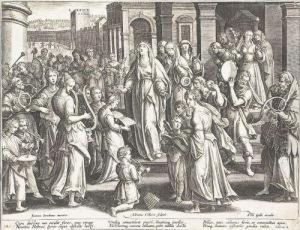Johannes Stradamus Paintings
Johannes Stradamus, also known as Jan van der Straet or Giovanni Stradano, was a Flemish artist of the Renaissance period, born in Bruges, present-day Belgium, in 1523. His work is characterized by a blend of Flemish and Italian Renaissance styles, reflecting his training in his homeland as well as his extensive time in Italy, where he was active for the majority of his career.
Stradamus received his initial artistic training in the workshop of Pieter Aertsen in Antwerp, a city that was a significant center of art in the 16th century. He developed his skills in the Northern Renaissance tradition, which was known for its detailed observation of the world and emphasis on domestic and religious subjects.
In 1545, Stradamus moved to Florence, Italy, to further his career. This decision marked a turning point in his life and work. In Florence, he became associated with the Medici court, one of the most influential and important patrons of the arts during the Renaissance. His work in Italy allowed him to absorb the principles of the Italian Renaissance, characterized by its humanism, classical references, and emphasis on proportion and perspective.
Stradamus collaborated with Giorgio Vasari on the decoration of the Palazzo Vecchio in Florence and was involved in the Studiolo of Francesco I, a project that showcased his ability to incorporate intricate details and a wide range of subjects, from alchemy to natural history. His work often featured exotic animals and historical scenes, which were popular among the Medici and other wealthy patrons who desired representations of the expanding world during the Age of Discovery.
One of Stradamus' significant contributions to the visual arts was his series of engravings depicting the discovery of the Americas, titled 'Nova Reperta' (New Discoveries). These prints were widely distributed and influenced the European understanding and imagery of the New World.
Throughout his career, Stradamus remained productive and well-regarded. His style, which combined the precision and clarity of Northern European art with the grace and grandeur of the Italian Renaissance, made his work unique and sought after. He also produced altarpieces, frescoes, and tapestry designs, further showcasing his versatility as an artist.
Johannes Stradamus passed away in 1605 in Florence. Today, his works can be found in various museums and collections, illustrating the cross-cultural artistic exchanges that were a hallmark of the Renaissance. His legacy is that of an artist who successfully bridged the artistic traditions of the North and South of Europe, contributing to the richness of the Renaissance artistic canon.
